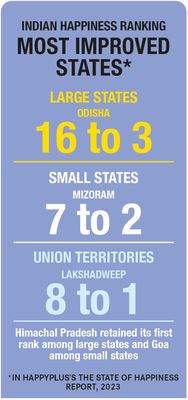Even the gods call it home, they say.
Nestled in the lap of the Himalayas, Himachal Pradesh has nature in all its diversity―from snow-capped mountains that meet the sky and desert valleys carved by gushing rivers and streams, to lush green deodar forests, apple orchards and terrace farms. It is as if nature has cocooned it from the harshness of modern-day life―soundproofed, slow and simple.
The yearning for all things slow and serene was beautifully captured by singer-songwriter Salman Elahi in his 2020 single ‘Mera Dil Kahi Pahadon Mein Kho Gaya [My heart is lost somewhere in the mountains]’. It soon became the mountain anthem for anyone who wanted to escape the chaos of cities during the Covid-induced lockdown―the work-from-home policy offered freedom of mobility, and while many returned to their hometowns, some moved to the mountains, seeking calm. For Manju Jaidka, the song sums up her bond with the quiet city of Solan, some 45km from Shimla. Originally from Chandigarh, she moved to Solan shortly before the lockdown was announced to begin her second innings as an academic post retirement. She is now senior professor and dean at Solan’s Shoolini University and helped set up its liberal arts department. Initially, she thought that the people of Solan were laidback but her views changed as she understood the place and its people better. “The beauty of the city is not limited to its locations. The people here are very simple, hardworking, have few needs and are not superficial,”she says. “They can bond with anyone. That’s the life I wanted to live.”The only drawback, she says, is the lack of proper medical facilities, which makes her children worry for her at times. But Himachal’s clean air and water would keep half the ailments away.
It, therefore, comes as no surprise that Himachal Pradesh tops the 2023 ‘The State of Happiness’rankings, conducted by human resources firm HappyPlus Consulting; it did so last year, too. The parameters considered for the survey include life ladder, social support, freedom of choice, generosity, perception of corruption, cost price index, state domestic product, literacy rate, life expectancy, poverty and health indices. Himachalis live a simple, uncomplicated life, making enough for themselves and their families. Tourism is a big contributor to the state’s economy, as are agriculture and apple production. While it is prone to natural disasters, Himachal has also seen lesser mishaps compared with Uttarakhand. The government’s developmental efforts, too, have made Himachal a people- and tourist-friendly space. For one, connectivity has improved, thanks to the construction of the Atal Tunnel, under the Rohtang Pass in the eastern Pir Panjal range of the Himalayas on the Leh-Manali Highway.
But what brought Pradeep, 59, to Himachal is art. When Covid-19 hit, the Pune-based IT employee wanted to move either to Kerala or Himachal to explore a new profession in the arts. He zeroed in on Andretta village in Himachal, and learned pottery from scratch. Today, he excels in making designer home décor, crockery and pots. His wife is an IT professional, and his daughter is in a college in Delhi; they visit him in the summers. He does not plan to go back to Pune. Why would he? Life is easy here, he says, the cost of living reasonable, and there is no traffic or pollution. Suraj Dikonda, 32, too, found work and home in Himachal. He moved to Bir with his family to set up a south Indian café―AVVA. He had first visited Bir as a paragliding tourist in 2017, and sensed a business opportunity. He asked his parents to move to Bir in 2018 and run the café while he continued to work as an advertising professional. “We come from a middle-class family and needed assurance first,” he says. “My mother, who hails from Nizamabad in Telangana, has always been a great cook. For six months, she experimented with recipes, understood the local taste and sourced ingredients.” In 2020, Suraj moved to Bir to expand the business and later that year quit his job as the caféreally took off. Apart from the cold weather and the difficulty in sourcing local ingredients, Dikonda says they did not face any challenges and that the people were hospitable and kind. The pandemic also allowed those from the mountains living in cities to return home. Ashish Thakur, a merchant navy officer, spent a few years in Himachal as a child before moving to Mumbai, where his father was posted as a customs captain. After saving enough money, the family built a house in Dharamshala. “In Himachal, people treat you like family,” he says. “There is peace of mind, culture, good atmosphere and the energy levels stay the same throughout the day. One never gets tired of exploring.” His happy places in Himachal are the temples in Kangra, monasteries in Dharamshala, nightlife in McLeodganj, sunrise and sunset views and the waterfalls. For author, screenwriter and journalist Meghna Pant, who was born in Shimla but spent most of her life in Mumbai, her hometown is all about memories. She remembers visiting her maternal grandmother’s “lopsided”house in Chota Shimla and playing hide-and-seek with her cousins every summer. And, she can still smell the spices wafting from the kitchen and taste the mango lassi and aloo paratha, and see the grazing goats, the slanted houses, the teashops and the valleys full of deodar, pine and rhododendron―all in her mind’s eye.
Pant says that Shimla gets its name from Shyamala Mata, a fearless incarnation of Goddess Kali. Happiness resides where there is no fear, she says, thereby making Himachal the happiest state in India.



